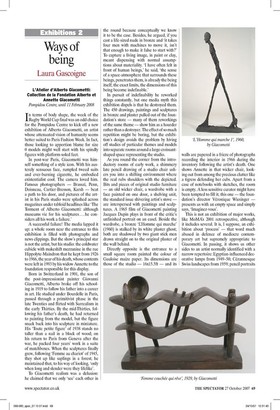Ways of bemg
Laura Gascoigne L'Atelier d'Alberto Giacometti: Collection de la Fondation Alberto et Annette Giacometti Pompidou Centre, until 1 1 Feb/vary 2008 In terms of body shape, the week of the Rugby World Cup final was an odd choice for the Pompidou Centre to kick off a new exhibition of Alberto Giacometti, an artist whose attenuated vision of humanity seems better suited to Paris Fashion Week. In fact, those looking to apportion blame for size models might well start with his spindly figures with platform-soled feet.
In post-war Paris, Giacometti was himself something of a style icon. With his austerely sensuous face, rumpled tweed suits and ever-burning cigarette, he embodied existentialist cool. The camera loved him Famous photographers — BrassaI, Penn, Doisneau, Cartier-Bresson, Karsh — beat a path to his door, and pictures of the artist in his Paris studio were splashed across magazines under tabloid headlines like 'The Torment of Alberto Giacometti: although museums vie for his sculptures ... he considers all his work a failure.'
A successful failure! The media lapped it up: a whole room near the entrance to this exhibition is filled with photographs and news clippings. But the show's principal star is not the artist, but his studio: the coldwater cubicle with makeshift mezzanine in the rue Hippolyte-Maindron that he kept from 1926 to 1966, the year of his death, whose contents were left in 1993 by his widow Annette to the foundation responsible for this display.
Born in Switzerland in 1901, the son of the post-impressionist painter Giovanni Giacometti, Alberto broke off his schooling in 1919 to follow his father into a career in art. He studied under Bourdelle in Paris, passed through a primitivist phase in the late Twenties and flirted with Surrealism in the early Thirties. By the mid-Thirties, following his father's death, he had returned to painting from the model, but the figure snuck back into his sculpture in miniature. His `Toute petite figure' of 1938 stands no taller than a nail in a block of wood; on his return to Paris from Geneva after the war, he packed four years' work in a suite of matchboxes. When the sculptures finally grew, following 'Femme au chariot' of 1945, they shot up like saplings in a forest; he maintained that, to his way of looking, 'only when long and slender were they lifelike'.
To Giacometti realism was a delusion: he claimed that we only 'see' each other in the round because conceptually we know it to be the case. Besides, he argued, if you cast a life-sized nude in bronze and 'it takes four men with machines to move it, isn't that enough to make it false to start with?' To capture a living image, in paint or clay, meant dispensing with normal assumptions about materiality. 'I have often felt in front of human beings,' he said, 'the sense of a space-atmosphere that surrounds these beings, penetrates them, is already the being itself; the exact limits, the dimensions of this being become indefinable.'
In pursuit of indefinability he reworked things constantly, but one media myth this exhibition dispels is that he destroyed them. The 450 drawings, paintings and sculptures in bronze and plaster pulled out of the foundation's store — many of them reworkings of the same theme — show him as a hoarder rather than a destroyer. The effect of so much repetition might be boring, but the exhibition's design avoids the problem by hiving off studies of particular themes and models into separate rooms around a large croissantshaped space representing the studio.
As you round the corner from the introductory rooms of early work, a shimmery late pencil drawing of a studio chair ushers you into a shifting environment where the real rubs shoulders with the depicted. Bits and pieces of original studio furniture — an old wicker chair, a wardrobe with a face painted on one door, a shelving unit, the standard issue shivering artist's stove — are interspersed with paintings and sculptures. A 1965 film of Giacometti painting Jacques Dupin plays in front of the critic's unfinished portrait on an easel. Beside the wardrobe, a bronze T:Homme qui marche' (1960) is stalked by its white plaster ghost; both are shadowed by two giant stick men drawn straight on to the original plaster of the wall behind.
Directly opposite is the entrance to a small square room painted the colour of Gauloise maize paper. Its dimensions are those of the studio — 16x15.5ft — and its walls are papered in a frieze of photographs recording the interior in 1966 during the inventory following the artist's death. One shows Annette in that wicker chair, looking out from among the precious clutter like a tigress defending her cubs. Apart from a case of notebooks with sketches, the room is empty. A less sensitive curator might have been tempted to fill it; this one — the foundation's director Veronique Wiesinger — presents us with an empty space and simply says, 'Imaginez-vous'.
This is not an exhibition of major works, like MoMAs 2001 retrospective, although it includes several. It is, I suppose, an exhibition about 'process' — that word much abused in defence of mediocre contemporary art but supremely appropriate to Giacometti. In passing, it shows us other sides to an artist normally identified with a narrow repertoire: Egyptian-influenced decorative lamps from 1949-50; Cezannesque Swiss landscapes from 1959; pencil portraits of Matisse from 1954; and drawings after the masters — Diner, Signorelli, Titian, Rubens, Cezanne — from throughout his life. A Chardin self-portrait drawing copied stroke for stroke backs up his youthful claim that he could copy anything. Later, he came to the conclusion that 'one never copies anything but the vision that remains of it at each moment ... that's to say, it really always is between being and not being. And that is what one wants to copy.'



































































 Previous page
Previous page